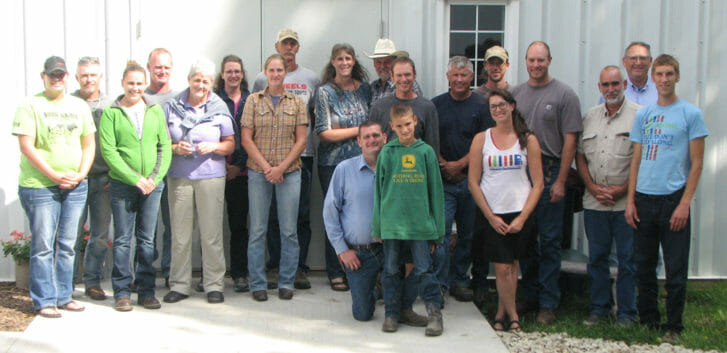Bud Williams’ Legacy Lives On: Marketing and Proper Stockmanship School
Bud Williams, famous for designing the ‘Bud Box’, was a cattle handling expert known throughout the world. To continue his legacy, Bud’s daughter Tina, and her husband Richard McConnell, of Hand ‘n Hand Livestock Solutions, have been imparting Bud’s knowledge on farmers who attend schools taught throughout North America. Tina and Richard were in southwest Iowa to teach both livestock marketing and proper stockmanship techniques. A group of 20 farmers participated in the course over the course of four days.

Farmers ready to practice their new-found cattle handling skills on their herds!
Marketing
The focus of the marketing portion of the course was on selling high and buying low – in other words – always sell over-valued animals and buy under-valued animals. Tina is a whiz at Excel and has come up with some fantastic spreadsheets to help cattle owners determine what your cattle are worth in current markets, when to sell them, and how much you must receive for them to make a profit. The same goes for determining what cattle to buy and when to buy. We also learned how to calculate our ‘cost to keep’, which is the cost to produce your product, and is critical to know when making marketing decisions. If you take one of Tina and Richard’s classes you will receive their excel files and have the chance to work through many calculations with fellow farmers!
An excellent spreadsheet to keep track of your income and expenses in various livestock enterprises and videos showing you how to use the spreadsheet can be found at the Western Beef Development Center website.
Proper Stockmanship
The recurring theme of the stockmanship course was, “less is more, slow is fast, and time is an illusion.” We were taught when working cattle, you really shouldn’t be working hard – proper stockmanship is all about very subtle movements. It’s important to stay calm, confident and assertive. Keep in mind that cattle don’t wear watches, so time constraints are only imposed by the handler. If proper stockmanship is practiced, livestock will quickly move to where you want them to go. If the handler gets stressed out because it’s taking too long, the livestock will pick up on this stress. We need to assume animals can read our minds – so manage your thoughts accordingly!
The three important aspects to working animals are: proper pressure, proper communication, and a proper attitude. Tina and Richard delved into the details in these three areas, thoroughly explaining how livestock handlers should act and think in order to handle animals with the least amount of stress possible. To read more about the lessons learned, see Margaret Chamas’ blog post from 2013, when this class was last offered in Iowa.
For anyone interested in learning more about marketing or stockmanship, I’d highly recommend this course! Details about the school can be found here. I think everyone who attended left feeling inspired and eager to practice driving their cattle herds. Last but not least, thanks to Meg Schmidt for hosting us in Exira!
